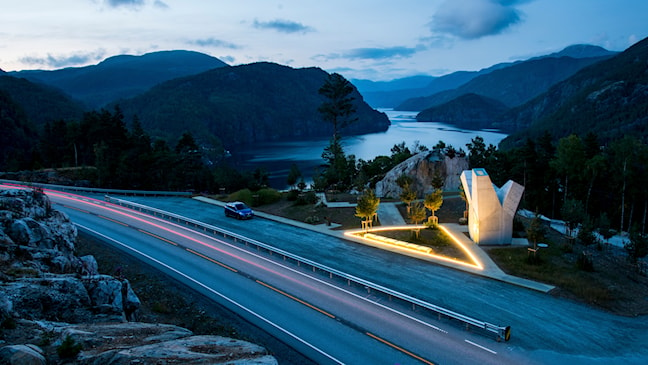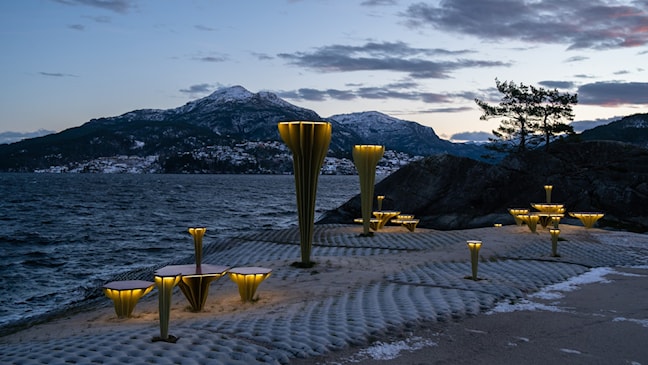KAP - Kontor for Arkitektur og Plan
Ostasteidn
Ostasteidn is situated straight north of the Sandsfjord Bridge on the west side of Sandsfjorden.
- Architect:
- KAP - Kontor for Arkitektur og Plan
- Finished:
- 2018

The project consists of a tall rock with straight lines, a separate toilet building and walkways leading to the seating benches by the viewpoints. In the shaping of the landscape, emphasis was placed on cultivating the qualities of this area. At the seating area in the north, the main point is the view of Sandsfjorden, and the seats by the rock have natural shelter from northwestern winds. The walkways are covered in fibreglass grating that provides good visual quality as well as being durable and open to vegetation. The grating is recurrent along edges, seats and tabletops, in combination with full fibreglass panels. The centre point of the area is the almost 6-metre-tall service building. With its raw, mossy concrete outside and wavy inside, it is centrally placed at the intersection of the walkways to the viewpoints. Local topsoil with heather has been restored in order to revegetate the area. In addition, a number of pine trees have been planted to recreate the original landscape.
Norwegian artist Lars Hertervig’s paintings inspired the architects’ design of the area. The painter is known for his characteristic portrayal of Ryfylke scenery.
Ropeid
- Architect:
- Jensen & Skodvin Arkitektkontor
- Architect:
- KAP - Kontor for Arkitektur og Plan
- Finished:
- 2004 og 2021

The new Sandsfjord Bridge replaced the ferry between Sand and Ropeid, thus reducing ferry activity as well as land use. The quay was left unused with large asphalt surfaces and rough rock materials down by the sea.
The idea behind the new rest area was to repair the landscape. The rest area is designed as a reconstruction of the original landscape form; the islet was dug free and contact with the sea restored. The broken sea line was “bandaged” with concrete mattresses made with textile formwork, now forming artificial seaside rocks.
In the holes of the mattress, grass has been sown that will form a set pattern.
The mattress landscape contains furniture elements such as seats and tables, lanterns and lamps. The furniture forms mushroom-like structures in small clusters. They are made of materials from recycled plastic boats from Ryfylke.
According to the architect, the project is an approach to the landscape that blurs the distinction between culture and nature. The artificial imitates nature and the natural imitates the artificial.
Architect: KAP arkitekter
Completed 2021
The name Ropeid is believed to originate from the old days, when news from both sides, Suldal and Vindafjord respectively, was communicated by shouting - in Norwegian “rope” - across the fiord.
In 2004, when ferries were still in operation at Ropeid, the Norwegian Public Roads Administration completed a waiting room with toilets on the quay. The building has large glass surfaces that create a proximity to the fiord and the landscape, and a bare rough rock surface forms the inner wall. The beautiful waiting room is now in use as an open library and a venue for other cultural events.
Architect: Jensen & Skodvin Architects
Completed 2004